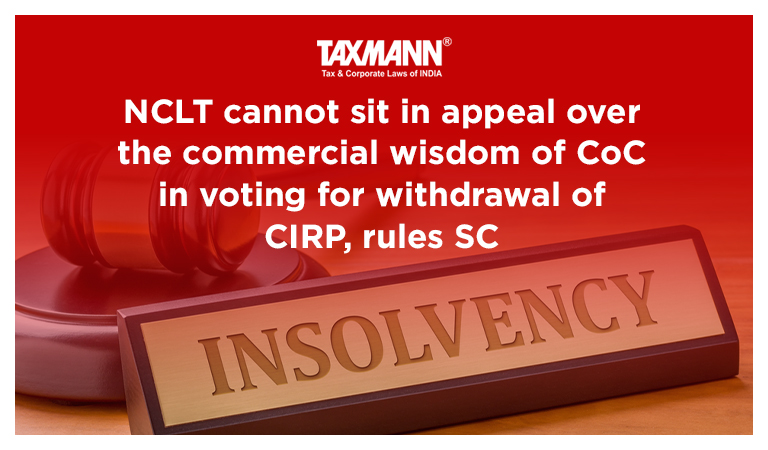NCLT cannot sit in appeal over the commercial wisdom of CoC in voting for withdrawal of CIRP, rules SC
- Blog|News|Insolvency and Bankruptcy Code|
- 2 Min Read
- By Taxmann
- |
- Last Updated on 6 June, 2022

Case Details: Vallal Rck v. Siva Industries and Holdings Ltd. - [2022] 139 taxmann.com 68 (SC)
Judiciary and Counsel Details
-
- B.R. Gavai & Hima Kohli, JJ.
Facts of the Case
In the instant case, an appeal was filed before the Apex Court challenging the order passed by the NCLAT, the question for consideration in the appeal was whether the NCLT or the NCLAT can sit in an appeal over the commercial wisdom of the Committee of Creditors or not?
Supreme Court Held
The Apex Court held that when 90% and more of the creditors, in their wisdom after due deliberations, find that it will be in the interest of all the stake-holders to permit settlement and withdraw CIRP, the Adjudicating Authority or the Appellate Authority cannot sit in an appeal over the commercial wisdom of CoC.
The interference would be warranted only when the adjudicating authority or the appellate authority finds the decision of the CoC to be wholly capricious, arbitrary, irrational and de hors the provisions of the statute or the Rules.
“In the present case, the proceedings of the 13th, 14th and 15th meetings of CoC would clearly show that there were wide deliberations amongst the members of the CoC while considering the Settlement Plan as submitted by the appellant. Not only that, the proceedings would also reveal that after suggestions were made by some of the members of the CoC, suitable amendments were carried out in the Settlement Plan by the appellant. One of the members of the CoC having voting share of 23.60%, though initially opposed the Settlement Plant, subsequently decided to support the same. Accordingly, the NCLT itself, vide order dated 29th March 2021, directed the RP to reconvene the CoC meeting. As per the directions of the NCLT, on 1st April 2021, the 17th meeting of the CoC was reconvened, wherein the Settlement Plan was approved by 94.23% votes” the Apex Court observed
It is thus clear that the decision of the CoC was taken after the members of the CoC, had due deliberation to consider the pros and cons of the Settlement Plan and took decision exercising their commercial wisdom. Therefore, neither the learned NCLT nor the learned NCLAT were justified in not giving due weightage to the commercial wisdom of CoC.
Disclaimer: The content/information published on the website is only for general information of the user and shall not be construed as legal advice. While the Taxmann has exercised reasonable efforts to ensure the veracity of information/content published, Taxmann shall be under no liability in any manner whatsoever for incorrect information, if any.

Taxmann Publications has a dedicated in-house Research & Editorial Team. This team consists of a team of Chartered Accountants, Company Secretaries, and Lawyers. This team works under the guidance and supervision of editor-in-chief Mr Rakesh Bhargava.
The Research and Editorial Team is responsible for developing reliable and accurate content for the readers. The team follows the six-sigma approach to achieve the benchmark of zero error in its publications and research platforms. The team ensures that the following publication guidelines are thoroughly followed while developing the content:
- The statutory material is obtained only from the authorized and reliable sources
- All the latest developments in the judicial and legislative fields are covered
- Prepare the analytical write-ups on current, controversial, and important issues to help the readers to understand the concept and its implications
- Every content published by Taxmann is complete, accurate and lucid
- All evidence-based statements are supported with proper reference to Section, Circular No., Notification No. or citations
- The golden rules of grammar, style and consistency are thoroughly followed
- Font and size that’s easy to read and remain consistent across all imprint and digital publications are applied





